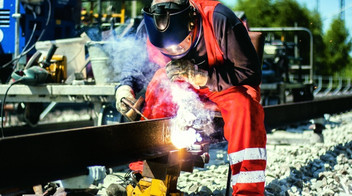Focus on digitalization projects
and concepts
Artificial intelligence in capacity management
DB Group got the ball rolling on state-of-the-art technologies such as AI at an early stage and tested the first applications back in 2017. We use AI in specific areas where it makes a real difference to DB Group – more trains departing on time, faster and more precise information for customers, quality levels that customers can rely on. AI is used as early on as the scheduling and smart control of transport and extends right through to the digitalization of maintenance.
Having successfully completed the pilot phases, we are now moving on to the actual implementation and widespread use of AI. The objective is to connect the dots to form an intelligent network and to implement pilot projects quickly, in a standardized manner and across all business units.
- AI factory: We have reinforced this objective by establishing an AI factory with about 150 employees. This will expand on the initiatives that are already underway in the various business units.
- Intelligent capacity management: Thanks to intelligent capacity management, which is a combination of tools for scheduling, rail operations and ex-post analyses of operations, over 100,000 minutes of delay were saved in 2023. The process of operational capacity management involves regulated interaction between the control centers of the TOCs and the RICs. This process-related cooperation is underpinned by two different AI approaches that follow differing regulations and targets. Both approaches are aimed at improving punctuality. Punctuality is paramount for the TOCs. The infrastructure dispatchers strive for optimal capacity utilization across the board. In other words, they try to achieve the greatest possible punctuality for all trains running on the rail network without favoring individual TOCs. The ADA-PMB assistance system provides support in certain pilot areas.
- Use of AI dispatch: The AI dispatch process, developed in our AI factory and currently in pilot operation, supports control center dispatchers in managing transport as efficiently as possible when incidents occur. The AI processes the current operating situation by the second based on about 500 pieces of information per minute and generates its suggestions from this. Based on live operations, it continuously simulates the development of the traffic situation and reports potential conflicts early on. This enables the dispatchers to intervene before a disruption occurs. As of 2021, the process has been used on the Stuttgart and Rhine-Main S-Bahn (metro) lines and, as of 2022, in Munich, preventing more than 58,000 minutes of delay. This has resulted in a significant improvement in the tightly timed metropolitan S-Bahn (metro) network. Due to the positive results from the pilot project, there are plans to run pilot projects on the S-Bahn (metro) lines in Berlin and Hamburg as well as other routes in 2024.
- Passenger information: AI is also used with respect to passenger information: using machine learning and big data technology, we have trained an algorithm to predict when, where and why trains generate delays. Every day, about 150 million forecasts are generated for already about 20,000 journeys, which are communicated via channels such as the DB Navigator. AI also automatically analyzes customer feedback received through various channels such as QR codes on trains, the DB Navigator or the ICE portal. The feedback is filtered in real time, sorted by topic and forwarded to the train personnel and employees at the facilities as quickly as possible. This enables personnel to respond in a quicker and more targeted manner.
- Maintenance: In maintenance, we use AI for tasks such as visually identifying damages at DB Long-Distance, DB Regional and DB Cargo.
Connectivity
Rail passengers have increasingly come to expect excellent data and cell phone connections as a matter of course. To meet these demands, DB Group is working with cell phone providers to close gaps in the cell phone network along tracks and further expand bandwidths. Expansion is progressing faster than planned:
- Deutsche Telekom has already provided LTE for telephone calls and data with speeds of more than 200 Mbit/s on 97% of DB Group’s main lines. In 2021, DB Group and Deutsche Telekom agreed to supply DB Group’s entire rail network with high-performance mobile communications coverage without gaps by the end of 2026: > 200 Mbit/s on busy routes, > 100 Mbit/s on other lines. To achieve this, capital expenditures in the three-digit million euro range are underway.
- Vodafone customers shall be able to make calls and surf the Internet largely without interruption on at least about two-thirds of all lines as early as 2025.
The basis for this is not only cell phone reception along the track, but also an improvement in the mobile signal permeability of trains. Together with its partners, DB Group has developed state-of-the-art laser technology to make windows on existing trains permeable to mobile signals by means of lasering. The window panes on these trains are coated with a wafer-thin layer of metal to protect them from heat. It is difficult for mobile signals to penetrate this metal layer. To make them more permeable, a fine mesh structure is incorporated into the metal layer using a laser. The intricate pattern allows mobile signals to enter the train’s interior about 100 times better than before. The millimeter-thin lines have only a minimal effect on thermal insulation and therefore on-board comfort. The technology is already in use on some regional trains in Bavaria, Berlin and Brandenburg. DB Long-Distance is also investing about € 50 million to have about 70,000 window panes in more than 3,300 passenger cars lasered. New long-distance trains and many new local transport trains are already equipped with mobile signal-permeable windows.
Data usage on trains will continue to increase significantly in the coming years. Gigabit transmission rates are required for passengers to enjoy telephone and data connections on board at the quality that will be customary for mobile communications in the future. Further digitalization of rail operations also necessitates high-performance transmission technologies along the track, as the 5G-based Future Railway Mobile Communication System (FRMCS) is set to replace the 2G-based GSM-R mobile communications standard. DB Group is therefore working with partners to develop a concept for setting up comprehensive 5G mobile communications infrastructure along tracks in Germany. Up to the end of 2024, the “Gigabit Innovation Track” funding project will be running tests on a 10-km-long test route to determine how the required high transmission rates for passengers can be achieved and how the necessary infrastructure can be set up quickly and in a way that conserves resources.
The need for reliable 5G mobile communications infrastructure is also growing when it comes to train maintenance. To this end, DB Group has piloted a 5G campus network at the Krefeld maintenance depot. This ensures high usability and excellent quality in open-air test sites, in the facility and on/beneath the train. A further 5G campus network for the state-of-the-art Cottbus maintenance depot has now also been put out to tender.
Digital Rail for Germany
Digitalization, automation and AI are the key to higher capacity and optimal utilization of the rail network as well as to improving quality and punctuality. The digitalization of track infrastructure as part of the Digital Rail Germany (Digitale Schiene Deutschland; DSD) initiative includes equipping infrastructure and vehicles. The objective of DSD will be achieved in two stages using various technologies:
- First of all, a digital basis will be established for the infrastructure as part of “Level 1 Plus.” This includes digital interlocking (DSTW), the European Train Control System ETCS (Level 2) and highly Automatic Train Operation (ATO GoA2).
- Building on this, more extensive digitalization will be tackled in Level 2: using train-centric safety logic for driving at the optimum distance from other vehicles, intelligent capacity planning and traffic control as well as fully Automatic Train Operation (ATO GoA4). In addition to command and control technology (DSTW, ETCS), transmission systems (FRMCS, bbiP), modern and standardized operating systems (integrated command and control system; iLBS) and ETCS vehicle equipment are crucial for both Level 1 Plus and Level 2.
The implementation of DSD has started in 2020. As part of the launch package, concrete planning and installation of ETCS and digital interlocking began in the context of the Stuttgart Digital Hub (Digitaler Knoten Stuttgart; DKS), the Cologne — Rhine/Main high-speed line and the ability to traverse the Trans-European Scandinavia — Mediterranean corridor (ScanMed). Stuttgart will be the first region in Germany to receive the digital train control and interlocking technology. In order to support the corresponding refitting of vehicles, the BMDV published a vehicle funding directive for the affected vehicles in the DKS, meaning that the vehicle retrofitting process could begin in 2022.
Following the completion of the Sensors4Rail 2023 development project, a fully automated, driverless provisioning and stabling run will be carried out for the first time within the next three years as part of the follow-up Automated Train project. This will include a fully automated set-up and shutdown process among other things. In addition, sensor-based obstacle detection will be used to demonstrate intervention in the vehicle control system.
The iLBS was introduced for the first time at an operating site for regular operation in September 2023. It brings together all applications required for operation and standardizes operation irrespective of the manufacturer. This standardization simplifies operation, training and maintenance considerably. The binding nature of the DSD equipment planning up to 2028 was established by publishing as part of the updated network terms and conditions of use in July 2023.
The main change in the updated DSD rollout planning up to 2030 is the inclusion of the general modernization of the high-performance network. This will accelerate the digitalization of the rail network along the high-performance routes and ensure an early increase in capacity. Obsolescence and operational issues are also being addressed. Digitalization of the rail network is a decisive and inevitable step in this direction. DSD is a major lever for advances in Germany’s transition to more sustainable mobility.
DB Group as part of Europe’s Rail
Europe’s Rail is the European initiative on research, innovation and system integration in the railway sector. The partnership aims to strengthen the cost efficiency, integration and competitiveness of the rail sector in order to achieve the overall vision of a European rail system without system disruptions. For example, work is being done to harmonize the system architecture and on the technical specifications for interoperability (TSI). Other key topics are the digitalization of freight transport with the digital automatic coupling (DAC) and the digitalization of command and control technology through to automatic train operation (ATO).
Digital maintenance
Digitalization and automation of maintenance will increase the availability of vehicles and facilities.
- The digitalization of vehicle fleets for better condition monitoring is progressing. Digitalization has begun on about 800 vehicles from three series. The first 350 vehicles were equipped with sensors and/or diagnosis boxes to use condition data from the vehicles for condition-based maintenance and thus better asset productivity, availability and cost structures. By the end of 2026, all vehicles are to be converted and shall serve as a blueprint for further series. Due to operationally driven reprioritizations, this has been delayed relative to the original plan.
- Digital fleet control is being implemented at DB Regional as a central element of digital vehicle maintenance. The rollout of the “dLox” application to aid train staff in technically recording damage to trains was also rolled out at DB Regional after successful use at DB Cargo. About 28,000 employees at DB Cargo and DB Regional currently use the application in daily operations.
- Automation and digitalization in the depots are gaining momentum. In 2023, the number of automated drive-over measuring systems increased to 11. A total of 14 wheel set measuring systems will be put into operation at the end of 2024. All DB Long-Distance depots and almost all metropolitan S-Bahn (metro) trains at DB Regional will then have these modern facilities, which will significantly reduce manual work and work hours.
- The AI-based material recognition system successfully introduced by DB Long-Distance began to be rolled out in other business units. At a future date, the application DB.Mat.ID will be available to about 15,000 maintenance employees and will simplify the search for materials. By matching a photo with an image database, the correct component is identified quickly and safely.
- We made further progress with digitalization in the area of vehicle maintenance in 2023: the introduction of digital feedback for performance recording, which started in Kassel in 2022, was rolled out in other workshops. Furthermore, the groundwork was laid to start digitally recording test characteristics in the wheel set workshop in Kassel at the beginning of 2024.


